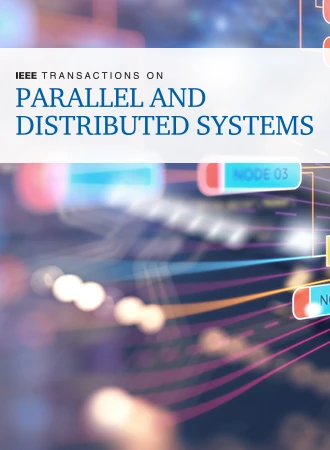通过数据中心内和数据中心间调度实现超负荷情况下的自适应 QoS 感知微服务部署
IF 5.6
2区 计算机科学
Q1 COMPUTER SCIENCE, THEORY & METHODS
IEEE Transactions on Parallel and Distributed Systems
Pub Date : 2024-07-10
DOI:10.1109/TPDS.2024.3425931
引用次数: 0
摘要
面向用户的应用程序经常会遇到负载过重的问题,因此正在转向微服务架构。为了充分利用异构资源,目前的数据中心采用了分解存储和计算的架构,存储集群和计算集群分别适合部署有状态和无状态的微服务。此外,当本地数据中心的资源不足以承载过多负载时,合理的解决方案是将部分微服务转移到远程数据中心。然而,由于微服务显示出不同的特性,本地数据中心也显示出不同的资源争用情况,要决定在本地数据中心内部署适当的微服务并确定向远程数据中心迁移的适当决策并非易事。因此,我们提出了一个数据中心内和数据中心间的调度系统--ELIS,它能确保微服务应用的服务质量(QoS),同时最大限度地减少网络带宽使用量和计算资源使用量。ELIS 由资源管理器、跨集群微服务部署器和基于奖励的微服务迁移器组成。资源管理器为微服务分配接近最优的资源,同时确保服务质量。微服务部署器在本地数据中心的存储集群和计算集群之间部署微服务,在满足微服务资源需求的同时尽量减少网络带宽的使用。当本地资源无法承受过多负载时,微服务迁移器会将一些微服务迁移到远程数据中心。实验结果表明,ELIS 确保了面向用户的应用程序的服务质量。同时,它将公共网络带宽使用率、远程计算资源使用率和本地网络带宽使用率分别平均降低了 49.6%、48.5% 和 60.7%。本文章由计算机程序翻译,如有差异,请以英文原文为准。
Adaptive QoS-Aware Microservice Deployment With Excessive Loads via Intra- and Inter-Datacenter Scheduling
User-facing applications often experience excessive loads and are shifting towards the microservice architecture. To fully utilize heterogeneous resources, current datacenters have adopted the disaggregated storage and compute architecture, where the storage and compute clusters are suitable to deploy the stateful and stateless microservices, respectively. Moreover, when the local datacenter has insufficient resources to host excessive loads, a reasonable solution is moving some microservices to remote datacenters. However, it is nontrivial to decide the appropriate microservice deployment inside the local datacenter and identify the appropriate migration decision to remote datacenters, as microservices show different characteristics, and the local datacenter shows different resource contention situations. We therefore propose ELIS, an intra- and inter-datacenter scheduling system that ensures the Quality-of-Service (QoS) of the microservice application, while minimizing the network bandwidth usage and computational resource usage. ELIS comprises a
resource manager
, a
cross-cluster microservice deployer
, and a
reward-based microservice migrator
. The resource manager allocates near-optimal resources for microservices while ensuring QoS. The microservice deployer deploys the microservices between the storage and compute clusters in the local datacenter, to minimize the network bandwidth usage while satisfying the microservice resource demand. The microservice migrator migrates some microservices to remote datacenters when local resources cannot afford the excessive loads. Experimental results show that ELIS ensures the QoS of user-facing applications. Meanwhile, it reduces the public network bandwidth usage, the remote computational resource usage, and the local network bandwidth usage by 49.6%, 48.5%, and 60.7% on average, respectively.
求助全文
通过发布文献求助,成功后即可免费获取论文全文。
去求助
来源期刊

IEEE Transactions on Parallel and Distributed Systems
工程技术-工程:电子与电气
CiteScore
11.00
自引率
9.40%
发文量
281
审稿时长
5.6 months
期刊介绍:
IEEE Transactions on Parallel and Distributed Systems (TPDS) is published monthly. It publishes a range of papers, comments on previously published papers, and survey articles that deal with the parallel and distributed systems research areas of current importance to our readers. Particular areas of interest include, but are not limited to:
a) Parallel and distributed algorithms, focusing on topics such as: models of computation; numerical, combinatorial, and data-intensive parallel algorithms, scalability of algorithms and data structures for parallel and distributed systems, communication and synchronization protocols, network algorithms, scheduling, and load balancing.
b) Applications of parallel and distributed computing, including computational and data-enabled science and engineering, big data applications, parallel crowd sourcing, large-scale social network analysis, management of big data, cloud and grid computing, scientific and biomedical applications, mobile computing, and cyber-physical systems.
c) Parallel and distributed architectures, including architectures for instruction-level and thread-level parallelism; design, analysis, implementation, fault resilience and performance measurements of multiple-processor systems; multicore processors, heterogeneous many-core systems; petascale and exascale systems designs; novel big data architectures; special purpose architectures, including graphics processors, signal processors, network processors, media accelerators, and other special purpose processors and accelerators; impact of technology on architecture; network and interconnect architectures; parallel I/O and storage systems; architecture of the memory hierarchy; power-efficient and green computing architectures; dependable architectures; and performance modeling and evaluation.
d) Parallel and distributed software, including parallel and multicore programming languages and compilers, runtime systems, operating systems, Internet computing and web services, resource management including green computing, middleware for grids, clouds, and data centers, libraries, performance modeling and evaluation, parallel programming paradigms, and programming environments and tools.
 求助内容:
求助内容: 应助结果提醒方式:
应助结果提醒方式:


